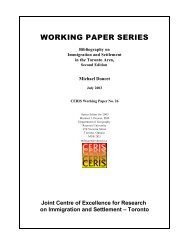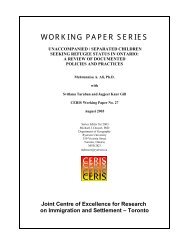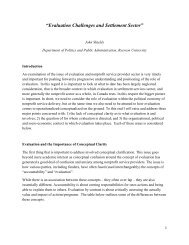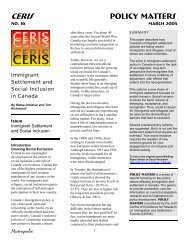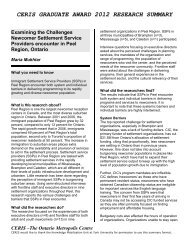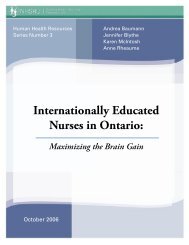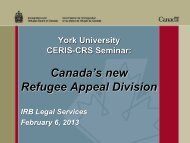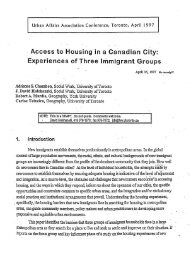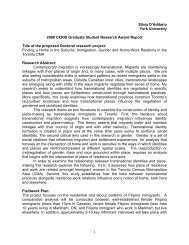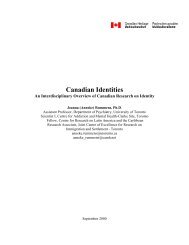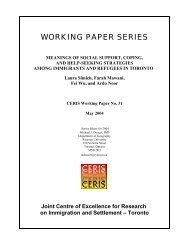Ethno-Racial Inequality in the City of Toronto: An Analysis of the ...
Ethno-Racial Inequality in the City of Toronto: An Analysis of the ...
Ethno-Racial Inequality in the City of Toronto: An Analysis of the ...
You also want an ePaper? Increase the reach of your titles
YUMPU automatically turns print PDFs into web optimized ePapers that Google loves.
IntroductionThis Report provides detailed descriptions <strong>of</strong> <strong>the</strong> socio-economic situations <strong>of</strong> 89 ethno-racial groups withat least 2,500 members <strong>in</strong> <strong>the</strong> <strong>City</strong> <strong>of</strong> <strong>Toronto</strong>. Us<strong>in</strong>g <strong>the</strong> 1996 Canadian Census, <strong>the</strong> goal is to identifygroups experienc<strong>in</strong>g significant disadvantage <strong>in</strong> education, employment and <strong>in</strong>come. For education, <strong>the</strong>focus is on <strong>the</strong> atta<strong>in</strong>ment <strong>of</strong> adults between 25 and 64 and on <strong>the</strong> atta<strong>in</strong>ment and school enrollment <strong>of</strong>youth. For employment, <strong>the</strong> measures <strong>in</strong>clude <strong>the</strong> rates <strong>of</strong> labour force participationand unemployment,<strong>the</strong> percentage <strong>of</strong> part-time work, <strong>the</strong> extent <strong>of</strong> and <strong>in</strong>come from self-employment, <strong>the</strong> distribution <strong>of</strong>occupations, and <strong>the</strong> median employment <strong>in</strong>come, with separate figures for women and men and foryouth and adult unemployment. The <strong>in</strong>cidence <strong>of</strong> poverty and median <strong>in</strong>comes, for families and for<strong>in</strong>dividuals liv<strong>in</strong>g on <strong>the</strong>ir own, are used to measure <strong>the</strong> standard <strong>of</strong> liv<strong>in</strong>g <strong>of</strong> ethno-racial groups.Chapter 1 shows how ethno-racial groups were identified from <strong>the</strong> 1996 Census. This is notstraightforward because <strong>the</strong> Census allows ethno-racial groups to be def<strong>in</strong>ed <strong>in</strong> a variety <strong>of</strong> ways andbecause it is necessary to classify <strong>the</strong> large number <strong>of</strong> people, about one third <strong>of</strong> <strong>the</strong> population, who givemore than one answer to <strong>the</strong> Census question about <strong>the</strong>ir ancestry. This chapter also provides <strong>the</strong>demographic characteristics <strong>of</strong> ethno-racial groups <strong>in</strong> <strong>Toronto</strong>, <strong>in</strong>clud<strong>in</strong>g <strong>the</strong>ir age distributions, <strong>the</strong>proportion <strong>of</strong> immigrants and when <strong>the</strong>y came to Canada, knowledge <strong>of</strong> English and French, and <strong>the</strong>language spoken at home.The next three chapters deal with education, employment and <strong>in</strong>come. Periods <strong>of</strong> highunemployment and rapid <strong>in</strong>dustrial restructur<strong>in</strong>g may have weakened <strong>the</strong> l<strong>in</strong>k between educationalcredentials and good jobs, but formal education is still a good predictor <strong>of</strong> occupational success, even ifsome employers use educational qualifications only as a short-cut to avoid assess<strong>in</strong>g <strong>the</strong> skills <strong>of</strong>applicants. In <strong>the</strong> absence <strong>of</strong> a large-scale direct study <strong>of</strong> literacy <strong>in</strong> <strong>Toronto</strong>, formal education alsoprovides a useful, albeit imperfect, measure <strong>of</strong> literacy. It is likely that <strong>the</strong> success <strong>of</strong> ethno-racial groups<strong>in</strong> obta<strong>in</strong><strong>in</strong>g resources partly depends on <strong>the</strong> organizational resources and leadership provided by <strong>the</strong>irmore highly educated members.Additional analysis focusses on <strong>the</strong> levels <strong>of</strong> post-secondary school enrollment <strong>of</strong> young peoplebetween 20 and 24 and on <strong>the</strong> educational atta<strong>in</strong>ment <strong>of</strong> those no longer <strong>in</strong> school.<strong>Ethno</strong>-<strong>Racial</strong> <strong>Inequality</strong> <strong>in</strong> <strong>Toronto</strong>: <strong>An</strong>alysis <strong>of</strong> <strong>the</strong> 1996 Censusvii



